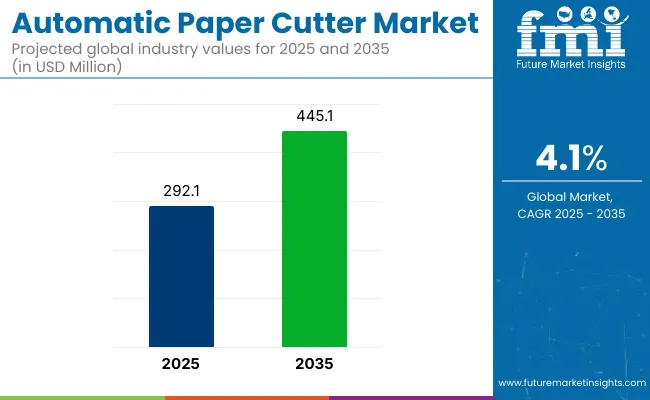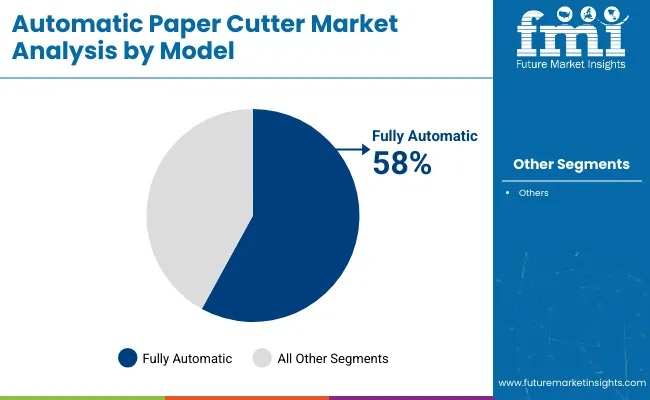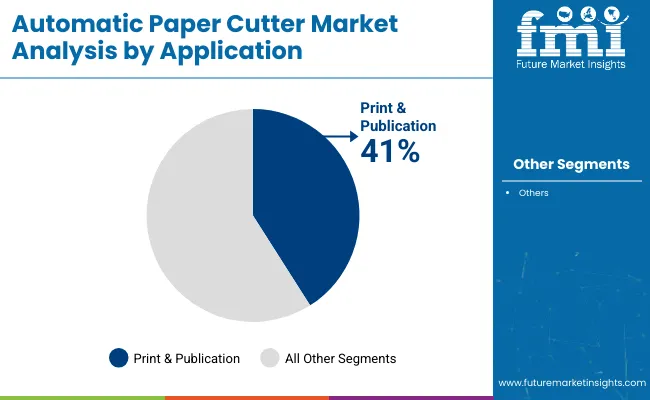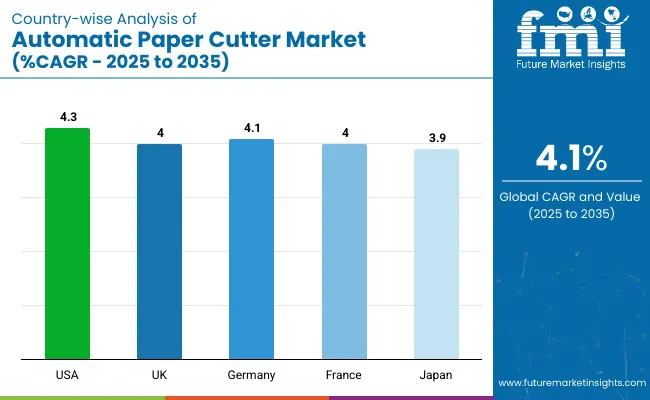The global automatic paper cutter market is valued at USD 292.1 million in 2025 and is slated to be worth USD 445.1 million by 2035, reflecting a CAGR of 4.1%. This growth is being driven by the rapid shift toward automation in printing and packaging, demand for high-speed cutting precision, and sustainable packaging adoption. The market's expansion is further supported by e-commerce proliferation and regulatory pushes toward energy-efficient manufacturing practices across developed and emerging economies.

| Metric | Value |
|---|---|
| Estimated Size (2025) | USD 292.1 million |
| Projected Value (2035) | USD 445.1 million |
| CAGR (2025 to 2035) | 4.1% |
North America is expected to remain the largest regional market by 2035, driven by its mature commercial printing and packaging sectors, particularly in the United States, which holds the largest market share. Germany is set to grow at a CAGR of 4.1% due to its leadership in industrial automation and precision manufacturing.
Among companies, leadership is likely to be retained by Ideal (Krug & Priester), owing to its digital automation capabilities and sustainable paper-cutting models. Fully automatic paper cutters will dominate the market with a significant share due to their programmable features and reduced manual intervention. Meanwhile, by application segment, the print & publication accounts for 41% of the market share.
Profitability is being witnessed by Duplo Corporation and Polar Mohr due to their strategic focus on digital print finishing and IoT-enabled automation. In contrast, traditional printing sectors in countries like Japan face saturation, which is hampering the demand for automatic paper cutters in these regions. High capital requirements and the declining use of paper in favor of digital documents remain challenges for small enterprises and mature economies with declining print media reliance.
The global automatic paper cutter market is segmented based on model (semi-automatic paper cutters, fully automatic paper cutters), application (pre-press printing, print & publication, paper mills processing, and paper packaging), and region (North America, Latin America, Western Europe, Eastern Europe, East Asia, South Asia Pacific, Middle East and Africa).
Fully automatic paper cutters hold 58% of the market share due to their high-speed precision, programmable features, and growing integration in large-scale commercial print environments. Increased adoption has been observed across North America and East Asia, especially in packaging and print houses, driven by the need to reduce labor costs and increase productivity in automated cutting lines.

The print & publication segment accounts for 41% share, supported by the rising demand for digital and on-demand printing solutions. Adoption is being driven by high-volume book printing, customized brochures, and magazine production, especially in the USA, UK, and Japan.

Recent Trends in the Market
Key Challenges

The automatic paper cutter market in the USA is anticipated to grow at a CAGR of 4.3% from 2025 to 2035. Market expansion is driven by automation in commercial printing, the booming e-commerce sector, and the shift toward sustainable paper packaging. High labor costs and strict workplace safety regulations are compelling enterprises to adopt smart, AI-powered paper cutting systems for enhanced efficiency and precision.
The automatic paper cutter market in the UK is projected to expand at a CAGR of 4.0% during the forecast period. This growth is driven by demand in commercial printing, on-demand publishing, and advertising sectors. The country’s strong emphasis on workplace safety, energy efficiency, and sustainable production has fueled the adoption of AI-integrated, low-waste paper-cutting technologies among SMEs and large-scale commercial facilities.
The automatic paper cutter market in Germany is expected to grow at a CAGR of 4.1% from 2025 to 2035. As a leader in industrial automation and precision manufacturing, Germany emphasizes high-speed and programmable cutting machines across its strong packaging and publishing sectors. Supportive sustainability regulations and investments in digital workflow integration are enabling further adoption across large enterprises.
High penetration of smart automation in paper processing lines.
The government pushes for sustainable and recyclable packaging.
Innovation-driven investments in AI-enabled finishing equipment.
The automatic paper cutter industry in France is forecasted to register a CAGR of 4.0% from 2025 to 2035. Market growth is supported by commercial printers and packaging companies focusing on low-waste production and operational automation. Strong eco-regulations and a cultural shift toward biodegradable packaging materials are accelerating the adoption of fully automatic, energy-efficient cutting machines across major industries.
The automatic paper cutter market in Japan is set to grow at a CAGR of 3.9% between 2025 and 2035. While the traditional print industry is slowing, growth is sustained through digital transformation and smart factory initiatives. Japan's emphasis on robotics, compact high-speed cutting systems, and real-time monitoring has enhanced cutting precision and operational reliability in customized and short-run printing.
The automatic paper cutter market is moderately consolidated, with several established firms, such as Baumfolder Corporation, Horizon International, Graphtec Corporation, MBM Corporation, Fujipla, EBA (Krug & Priester), Hefter Systemform, Daeho Machinery, Shanghai Eureka Machinery, and Tamerica Products Inc., holding significant influence through global distribution networks and strong R&D. Competitive dynamics are centered on innovation-led differentiation, strategic pricing, and regional expansion partnerships.
Top companies are competing by launching AI- and IoT-enabled cutters, offering smart feeding systems, and expanding into emerging markets via partnerships and selective acquisitions. Product innovation, particularly in programmable precision, touchscreen automation, and sustainable design, has emerged as a key differentiator, while pricing strategies are tailored to balance affordability with advanced features.
| Report Attributes | Details |
|---|---|
| Current Total Market Size (2025) | USD 292.1 million |
| Projected Market Size (2035) | USD 445.1 million |
| CAGR (2025 to 2035) | 4.1% |
| Base Year for Estimation | 2024 |
| Historical Period | 2020 to 2024 |
| Projections Period | 2025 to 2035 |
| Market Analysis Parameters | Revenue in USD millions/Volume in units |
| By Model | Semi-Automatic Paper Cutters, Fully Automatic Paper Cutters |
| By Application | Pre-Press Printing, Print & Publication, Paper Mills Processing, Paper Packaging |
| Regions Covered | North America, Latin America, Western Europe, Eastern Europe, East Asia, South Asia Pacific, Middle East and Africa |
| Countries Covered | United States, Canada, United Kingdom, Germany, France, China, Japan, South Korea, Brazil, Australia |
| Key Players | Baumfolder Corporation, Horizon International, Graphtec Corporation, MBM Corporation, Fujipla, EBA (Krug & Priester), Hefter Systemform, Daeho Machinery, Shanghai Eureka Machinery, Tamerica Products Inc. |
| Additional Attributes | Dollar sales by value, segment-wise share analysis, and country-wise growth comparison |
In terms of Model, the industry is divided into Semi-Automatic Paper Cutters, Fully Automatic Paper Cutters
In terms of Application, the industry is divided into Pre-Press Printing, Print & Publication, Paper Mills Processing, Paper Packaging
The report covers key regions, including North America, Latin America, Western Europe, Eastern Europe, East Asia, South Asia, and the Middle East and Africa (MEA).
The global automatic paper cutter market is estimated to be valued at USD 292.1 million in 2025.
By 2035, the market is expected to reach USD 445.1 million globally.
Fully automatic paper cutters lead the market with an estimated 58% share due to their precision and speed.
The automatic paper cutter market is anticipated to grow at a CAGR of 4.1% during the forecast period.
The USA is projected to register the fastest growth with a CAGR of 4.3% through 2035.






Full Research Suite comprises of:
Market outlook & trends analysis
Interviews & case studies
Strategic recommendations
Vendor profiles & capabilities analysis
5-year forecasts
8 regions and 60+ country-level data splits
Market segment data splits
12 months of continuous data updates
DELIVERED AS:
PDF EXCEL ONLINE
Automatic Riveting Equipment Market Forecast and Outlook 2025 to 2035
Automatic Powder Forming Machine Market Forecast and Outlook 2025 to 2035
Automatic Weigh Price Labeling Machine Market Size and Share Forecast Outlook 2025 to 2035
Automatic Bending Machine Market Size and Share Forecast Outlook 2025 to 2035
Automatic Transmission Market Size and Share Forecast Outlook 2025 to 2035
Automatic Emergency Braking System Market Size and Share Forecast Outlook 2025 to 2035
Automatic Impact Testing Machine Market Size and Share Forecast Outlook 2025 to 2035
Automatic Glue Machine Market Size and Share Forecast Outlook 2025 to 2035
Automatic Floodgate Market Size and Share Forecast Outlook 2025 to 2035
Automatic Die Cutting Machines Market Size and Share Forecast Outlook 2025 to 2035
Automatic Dependent Surveillance-Broadcast (ADS-B) System Market Size and Share Forecast Outlook 2025 to 2035
Automatic Silver Sintering Die Attach Machine Market Size and Share Forecast Outlook 2025 to 2035
Automatic Emergency Braking (AEB) Market Size and Share Forecast Outlook 2025 to 2035
Automatic Identification and Data Capture Market Size and Share Forecast Outlook 2025 to 2035
Automatic Transfer Switch Market Size and Share Forecast Outlook 2025 to 2035
Automatic Weapons Market Size and Share Forecast Outlook 2025 to 2035
Automatic Bottle Opener Market Size and Share Forecast Outlook 2025 to 2035
Automatic Hog Feeder Market Size and Share Forecast Outlook 2025 to 2035
Automatic Goat Waterer Market Size and Share Forecast Outlook 2025 to 2035
Automatic Wine Dispensers Market Size and Share Forecast Outlook 2025 to 2035

Thank you!
You will receive an email from our Business Development Manager. Please be sure to check your SPAM/JUNK folder too.
Chat With
MaRIA